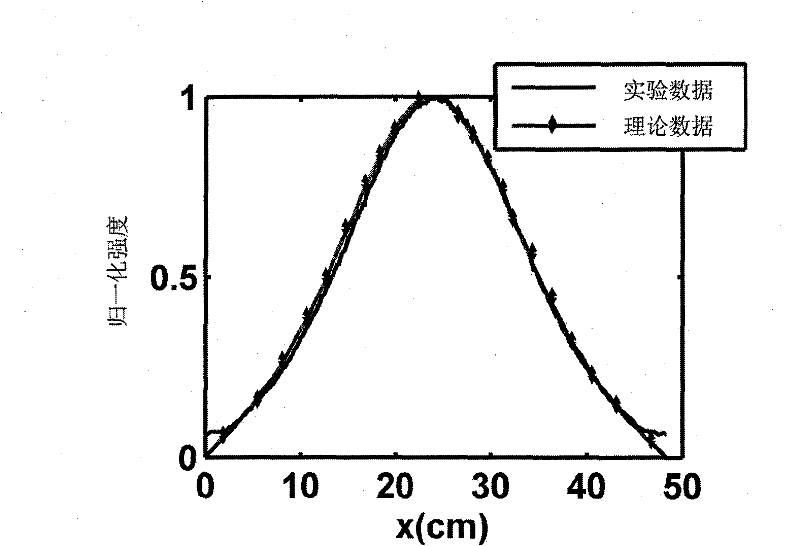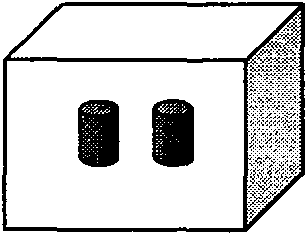Fluorescent molecular tomography method suitable for small animals
A technology of fluorescent molecular tomography and imaging methods, which is applied in the field of spectral technology applications, can solve the problems of no patents, etc., and achieve the effect of accurately positioning the position and intensity
- Summary
- Abstract
- Description
- Claims
- Application Information
AI Technical Summary
Problems solved by technology
Method used
Image
Examples
example 1
[0064] This example is mainly to prove the accuracy of the finite element method mentioned in the patent of the present invention to calculate the propagation of fluorescence in the body. The specific steps are: put 10% intralipid (fat emulsion solution) into a glass container with a length of 46.3 mm, a width of 19.2 mm and a height of 60 mm. On one side of the glass container, a 632.8nm He-Ne laser is used to irradiate the glass container vertically. On the other side of the glass container, a high-performance cooled CCD is used to record the light intensity. The optical parameters of the 10% fat emulsion solution mentioned in the literature are
[0065] 532NM 650NM 632.8NM
[0066] Absorption coefficient (1 / cm) 0.02 0.0023 0.0029
[0067] Scattering coefficient (1 / cm) 640 320 350
[0068] reduced scattering coefficient
[0069] (1 / cm) 109 59.9 61.1
[0070] Anisotropy factor 0.825 0.823 0.829
[0071] Table 110% intralipid solution optical parameters
[0072] From t...
example 2
[0074] This example mainly demonstrates that the method of this patent can be used to localize fluorescent markers in vivo. The specific steps are: put a pair of glass tubes (distance between 4.1mm and 2mm inner diameter of the glass tubes) equipped with quantum dot fluorescent markers into a glass container filled with 10% intralipid solution, the container is 46.3mm long and 19.2mm high 60mm, as attached figure 2 shown. Irradiate the glass container vertically with a 632.8 nm He-Ne laser. Then record the fluorescent light intensity on the other side of the glass container with a high-performance cooling CCD. Move the position of the laser 6 times, 2mm to the left each time. At the same time, a high-performance cooling CCD is used to record the fluorescence light intensity on the other side of the glass container. Then change the spacing of the glass tubes to 3.2mm, 2.1mm, 0.9mm, and repeat the above experiment process. Finally, the experimental data as D e , μ αe ,D ...
example 3
[0076] This example mainly proves that the method mentioned in this patent can be used to quantitatively detect the concentration of fluorescent markers. The specific steps are: a glass tube (with a distance of 4.1 mm and an inner diameter of 2 mm) equipped with a 100% concentration quantum dot fluorescent marker ) into a glass container containing 10% intralipid solution (7mm from the glass surface). The container is 46.3mm long, 19.2mm wide and 60mm high, as attached figure 2 shown. Irradiate the glass container vertically with a 632.8 nm He-Ne laser. Then record the fluorescent light intensity on the other side of the glass container with a high-performance cooling CCD. Move the position of the laser 6 times. Move 2mm to the left each time. At the same time, a high-performance cooling CCD is used to record the fluorescence light intensity on the other side of the glass container. Then change the concentration of quantum dot markers in the glass tube to 80%, 70%, 50%, ...
PUM
 Login to View More
Login to View More Abstract
Description
Claims
Application Information
 Login to View More
Login to View More - R&D
- Intellectual Property
- Life Sciences
- Materials
- Tech Scout
- Unparalleled Data Quality
- Higher Quality Content
- 60% Fewer Hallucinations
Browse by: Latest US Patents, China's latest patents, Technical Efficacy Thesaurus, Application Domain, Technology Topic, Popular Technical Reports.
© 2025 PatSnap. All rights reserved.Legal|Privacy policy|Modern Slavery Act Transparency Statement|Sitemap|About US| Contact US: help@patsnap.com



